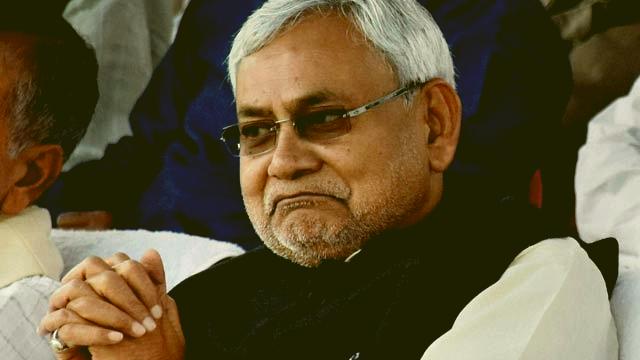Lalu Prasad Yadav and Nitish Kumar have a long, complicated past behind them. Both are products of anti-Congress student movements of the 70s, both were influenced by the Socialist ideologue Ram Manohar Lohia and the political stock of both Nitish and Lalu rose in the aftermath of Mandal commission report. For years, Lalu was seen as the leader, with Nitish as his number 2. Unlike Lalu’s gregarious self, Nitish’s quiet, studied demeanour, earned him the title of Chanakya. However, the intense caste-based politics of Bihar in the 90s drew the former friends apart. Nitish along with George Fernandes broke away from the Janata Dal and formed the Samta Party in 1994.
In 1996, Samta Party joined hands with the BJP and Nitish and Lalu became legendary rivals. Nitish swore to rid Bihar of Lalu’s Jungle Raj and grew ever closer to the BJP. The BJP on its part, propitiated Nitish Kumar and removed obstacles from his path to emerge as the unquestioned leader of Bihar. Nitish and the BJP tasted success in the polls held in October 2005 and from then there was no turning back. The JD(U)-BJP alliance grew from strength to strength, aided by the complementary nature of the two parties. The BJP was glad to play second fiddle to JD(U) as long as it kept rivals Congress and RJD at bay.
All seemed well until Modi-Shah duo arrived at the scene. Nitish Kumar, the Chief Minister of a state with a substantial Muslim minority who had voted for his party was uncomfortable with Narendra Modi and his image as ‘Hindu Hriday Samrat’. During the 2005 & 2010 assembly elections, Nitish had successfully thwarted BJP’s attempts to have Narendra Modi campaign in Bihar, to safeguard his pro-Muslim credentials. That the BJP readily acquiesced was because it was keen not to rock the boat.
But with Modi-Shah’s rise, Nitish now emerged as an implacable opponent of Narendra Modi’s prime ministerial candidature. As the 2014 Union elections drew nearer, the BJP-JDU alliance came under increasing strain, eventually forcing the time-tested allies BJP & JD(U) to part ways. 2014 completely changed the political landscape in the country. BJP swept the elections and Narendra Modi emerged as the unchallenged national leader. Of the 40 seats in Bihar, JD(U) could manage to win only 2, against BJP’s 22. Nitish Kumar’s humiliation was now complete. Nitish Kumar who had long been credited with sharp political acumen found himself cast away by Modi wave.
The opportunity came soon thereafter. In the bypolls to 10 assembly seats scheduled in August 2014, the JD(U), RJD and Congress stitched up an anti- Modi, Secular alliance. The opportunistic alliance, created solely to counter Modi, without any ideological compatibility, tasted victory and swept 6 of the 10 seats. Widely believed to be Nitish’s brain child, the anti-Modi alliance, by now called the Mahagathbandhan was strengthened further before the assembly elections due in 2015, where it decisively halted Modi’s juggernaut.
While Nitish believed that the voters would reward him for standing up against Modi, it was Lalu’s RJD that emerged as the single largest party within the Mahagathbandhan. Even though, outwardly, Lalu professed his love for Nitish and supported Nitish’s claim to Chief Minister’s chair, things had begun to get complicated. Nitish’s image took a hit as Lalu hoisted his sons on to Nitish’s cabinet. Statements by RJD leaders, for instance the one in which Rabri Devi asked Nitish to retire and pave the way for ‘youth leader’ Tejashwi to take over sullied the pitch.
Every now and then news of corruption cases against Lalu and his family made headlines. Even though Lalu was not in the cabinet, he ensured his influence in the government through his sons and supporters. Nitish Kumar’s image as that of a Vikas Purush gradually began to take a beating. But Nitish himself is no political novice. Having roughed it out through most of his political career, he is adept at dealing with situations to his advantage. He doesn’t always do what’s expected of him.
GST was one such occasion. While the rest of the opposition was crying itself hoarse over the decision, Nitish loudly praised the move. Prime Minister Narendra Modi was quick to reciprocate the gesture with his support for Nitish’s decision to implement prohibition in the state, even though state BJP leaders were not so enthused with the move. For Nitish, perhaps this was a way to test the waters in case the going got tough with Lalu and his ilk. Soon thereafter, Nitish began talking of Opposition unity for Presidential elections. After having been disappointed by the Congress during Assam and UP elections, Nitish wanted to ensure that a united front was forged against Modi.
Once again, Nitish was let down. Unlike earlier, this time Nitish was quick to announce his support for Ramnath Kovind as NDA’s Presidential candidate. He ascribed his support to the former’s exemplary tenure as the governor and Opposition’s failure to unite in time. Nitish’s decision earned him scorn from his Mahagathbandhan allies- Congress and RJD. Things came to such a pass that JD(U) functionaries started reminiscing of the respect with which BJP & NDA had treated them in the past. Nitish was quick to point out that “Mein kissi ke peechhe-peechhe nahin chalta, balki apni nitiyon par kayam rahta hoon”.
As monsoon sweeps across the country, torrential rains are forecast on the Mahagathbandhan. Nitish Kumar being himself would not want to pull the plug on the alliance.
On the other hand, he stand to lose very little if the Mahagathbandhan falls apart. He can easily retain his Chief Ministership with BJP’s support. His recent statements declaring himself to be unfit to be the Prime Minister indicate that he realizes that Modi’s time is far from over and the best strategy would be to live in peaceful cohabitation. After all, one cannot live in Rome and fight with the Pope.
